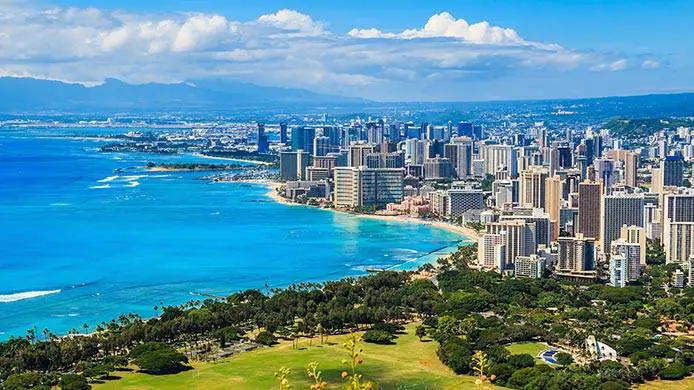Escape to the idyllic paradise of Hawaii, where swaying palm trees cast shadows on pristine beaches, and the gentle rhythm of ukulele melodies fills the air. Immerse yourself in the vibrant culture, mesmerizing landscapes, and warm aloha spirit that makes this archipelago a true haven for travelers seeking a slice of tranquility and adventure.
About Hawaii
Hawaii, a breathtaking archipelago nestled in the heart of the Pacific Ocean, captivates with its unparalleled beauty, where pristine beaches meet lush rainforests, and a vibrant cultural tapestry unfolds.
Geography
Hawaii’s allure extends beyond its natural wonders, as it is the only US state located outside of North America and boasts a fascinating history and diverse culture.
The Hawaiian Islands, a string of volcanic gems, stretch over 1,500 miles, forming an archipelago of eight main islands and a myriad of smaller ones.
Each island possesses a unique character, from the bustling metropolis of Honolulu on Oahu to the serene landscapes of Kauai, the “Garden Isle.”
Hawaii’s diverse ecosystems range from towering mountains to lush rainforests, cascading waterfalls to shimmering coastlines, creating a panorama of breathtaking natural beauty.
As the youngest state in the US, Hawaii’s volcanic origins continue to shape its dynamic landscape, with active volcanoes like Kilauea and Mauna Loa offering a glimpse into the Earth’s fiery heart.
Hawaii’s geographical isolation has also fostered the evolution of a unique flora and fauna, including the iconic Hawaiian monk seal and the endangered Hawaiian goose.
The islands’ rich marine life, including colorful coral reefs and playful sea turtles, attracts snorkelers and divers from around the world.
Hawaii’s geography not only defines its stunning landscapes but also serves as a testament to the state’s resilience and the transformative power of nature.
From the towering peaks of Mauna Kea to the secluded shores of Kalaupapa, Hawaii’s natural wonders captivate and inspire, making it a destination that will forever etch itself in the hearts of visitors.
Culture and History
Hawaii, a captivating archipelago in the Pacific, boasts a vibrant and distinctive culture, a rich tapestry woven from the vibrant threads of its indigenous Polynesian heritage and the subsequent influences of Western encounters.
Native Hawaiian Culture: A Tapestry of Spirituality, Family, and Environmental Reverence
The indigenous people of Hawaii, known as Native Hawaiians, hold a profound connection to the land, its bountiful resources, and the rhythms of nature. Their culture is deeply rooted in spirituality, reverence for the environment, and the unwavering bonds of family.
Native Hawaiian cultural practices are imbued with a deep-seated respect for the natural world. The concept of mālama, translated as “to care for,” guides their interactions with the environment, fostering a sustainable stewardship of their ancestral lands.
Ohana, the extended family unit, forms the cornerstone of Native Hawaiian society. Family ties are sacred, extending beyond blood relations to encompass a wider circle of individuals connected through shared experiences and cultural bonds.
Ancient hula, a captivating form of dance, music, and storytelling, holds immense cultural significance for Native Hawaiians. Through graceful movements and evocative chants, hula narrates historical events, honors ancestors, and connects the present to the past.
Traditional Hawaiian chants, known as oli, are another cherished cultural expression. These poetic compositions, rich in imagery and symbolism, convey stories, genealogies, and cultural teachings from generation to generation.
Poi, a staple food made from pounded taro root, represents the deep connection between Native Hawaiians and their land. Its preparation is an art form, requiring skilled hands to transform the starchy root into a smooth, creamy delicacy.
The Hawaiian language, ʻŌlelo Hawaiʻi, is a living testament to the cultural heritage of the Native Hawaiian people. Its unique vocabulary, grammar, and syntax reflect the intimate relationship between the language and the environment.
Traditional Hawaiian navigation techniques, honed over centuries, allowed skilled voyagers to traverse vast stretches of the Pacific Ocean. Using celestial bodies, ocean currents, and bird patterns, they navigated without compasses or modern instruments.
The petroglyphs found throughout the Hawaiian Islands are enigmatic remnants of the past, offering glimpses into the lives and beliefs of ancient Hawaiians. These carved images depict scenes of daily life, spiritual rituals, and cultural practices.
Heiau, sacred temple platforms, were central to Native Hawaiian spiritual practices. These structures, often located on prominent hilltops or near water, served as places of worship, ritual ceremonies, and gatherings.
Hawaiian cultural practices have undergone significant changes over time due to Western influences. However, the core values of spirituality, family, and environmental stewardship remain deeply ingrained in the lives of Native Hawaiians today.
Dear readers, as we conclude our journey through the mesmerizing islands of Hawaii, we hope you’ve experienced the captivating beauty and undeniable allure of this рай. From the volcanic landscapes of Big Island to the lush greenery of Maui, each island offers a unique symphony of nature’s wonders. May your memories of this enchanting archipelago inspire you to seek out more of the hidden gems that this planet has to offer. Aloha!
